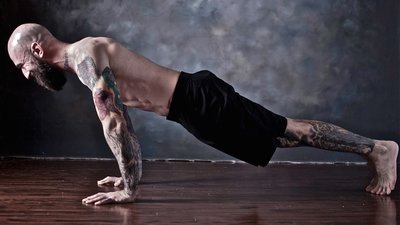As kids, my brother Danny and I spent a lot of time having push-up contests. If one of us could do 30 push-ups, the other had to do 31. Growing up, we thrived on the motivation of competing with each other in order to squeeze out those last reps. It wasn't long before 30 push-ups turned into 50. Then 50 turned into 70. Eventually, we were both obsessed with hitting triple digits.
What we didn't know back then, however, was that after a certain point, just adding more reps isn't the best way to keep progressing. It was only many years later—even after we had both become fitness professionals—that we became aware of a more effective approach, which we call "progressive calisthenics."
Instead of infinitely adding more reps of the exact same exercise, progressive calisthenics calls for you to advance to more difficult versions of the same movement pattern after you can demonstrate competency in the earlier progressions. By changing the leverage, altering the weight-to-limb ratio, or removing contact points, you can find ways to increase the workload without adding weight.
When it comes to building muscle and strength, resistance is resistance. If your muscles receive the proper stimulation to grow, they don't care if the resistance comes from an external object or your own bodyweight. But just as you need to progressively increase the poundage to keep getting stronger with weight training, you must also find ways to increase the intensity of your calisthenics training in order to keep pushing your body toward new growth.
The push-up is one of the clearest ways to see the principles of progressive calisthenics in action. Though sometimes unnoticeable to the untrained eye, these little changes can have a major impact on the difficulty of the exercise.
Here are five of my favorite ways to modify the push-up using the principles of progressive calisthenics.
1. Bring Your Hands Closer Together
This is one that every push-up aficionado usually figures out quickly enough. A standard push-up finds the hands placed slightly wider than shoulder-width. If you bring your hands closer to each other, however, the leverage shifts and the exercise becomes more difficult. Many people report feeling greater recruitment of the triceps and front delts when using the close hand position, though make no mistake, you will still get a major pump in your chest from doing close-grip push-ups for reps.

While it's common for folks to place their hands in a "diamond grip" when performing close-grip push-ups, I prefer something closer to an "arrow," where thumbs stay tucked together with the rest of my fingers. I find this helps facilitate keeping the elbows close to the body, which is a crucial subtlety for getting the most from this exercise.
2. Elevate Your Feet
Raising your feet up on an elevated surface places much more of your weight in your hands compared to a standard push-up. This means more work for your chest, arms, and shoulders. The higher you elevate your feet, the more difficult the move becomes.

Start with an elevated platform that's around 6-8 inches high, and gradually work your way up from there. Don't be surprised if you eventually find you want to kick up to vertical and explore the world of handstand push-ups!
3. Change Your Grip
Traditional push-ups involve keeping your hands flat on the floor throughout the entire range of motion. By changing to a knuckle or fingertip position, however, you create additional space between your body and the ground, which allows for an extended range of motion. This means you will have to bend your elbows farther in order to get your chest all the way down. By increasing the range of motion, you increase the amount of work that goes into every rep.

Additionally, the fingertip variant involves a whole slew of hand, finger, and forearm muscles that are neglected in the standard push-up.
4. Lower Your Hands Toward Your Hips
In a standard push-up, the hands are directly below the shoulders, but by lowering your hands closer toward your hips, you can increase the difficulty of the standard push-up without any external loading or equipment.

Though this is one of the subtler variations, placing the hands lower down decreases your leverage and places additional weight in your hands, making the exercise more difficult than it may appear. This variation can also provide a nice, deep stretch for your wrists.
5. Remove a Lower or Upper Contact Point
The most obvious way to increase the difficulty of a push-up is to completely remove a limb from the equation. It's pretty obvious that a one-arm push-up is a lot harder than one where you're pushing with both arms!

Though most people may not be ready to transition directly to the one-arm push-up, you can experiment with picking up one leg after you get comfortable with the standard push-up. Lifting a leg increases the core stabilization required to maintain proper alignment, making your push-up a bit more challenging. Eventually you may be ready to begin training for a one-arm push-up. When you're ready, picking up an arm and a leg is the ultimate push-up variation.
You can also combine methods from this list to create your own variations. There is always another challenge available for those who are willing to seek it out.
Anyone up for a feet-elevated, one-arm fingertip push-up?
For more information, pick up a copy of Al's latest book, "Street Workout."

